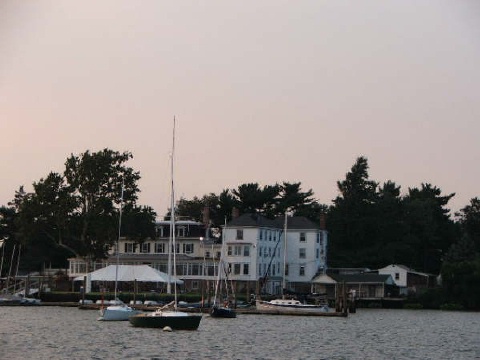
Corinthian Yacht Club of Philadelphia
Living the Dream
Six moons in the USA
Month 3
30 July to 29 August 2007
At 1300 hours on 30 July, with mixed emotions, we cast off the shorelines at Brielle Marine Basin. We waved goodbye to our relatives, most of whom had come to wave us off and had posed for photographs with us and “Light Blue”. Our hearts were in our throats and tears in our eyes, as we put on a brave face, concentrated on the job at hand and headed out through the narrow gap in the railroad bridge down the Manasquan Inlet and out into the Atlantic again.
At the same time as we were saying goodbye to our relatives, we were also saying goodbye to Fred and Joan, the owners of the Brielle Yacht Basin, with whom we had become very friendly and who had made our stay there so much easier and more pleasant than we could ever have imagined. They were always ready to assist us, by giving us information and advice. We had many conversations with them on diverse subjects about their and our home lives and their and our plans for the future. They were most generous and although the stay at Brielle necessarily depleted the Nunn coffers, we were grateful for their benevolence. We thank them both for their magnanimity.
We had made a list of tasks to complete on “Light Blue” while she was on the hard, which was a more economic method of storage than leaving her in the water in a slip. We had completed most if not all of the work and were delighted that she was looking as clean and polished as she had when we had left Plymouth, England 14 months before.
Having cleared the inlet at Manasquan we turned south and prepared for a 24-hour overnight sail down the flat and featureless New Jersey coastline and around Cape May before turning north into Delaware Bay. Our reason for undertaking this was that Barnegat Bay, which runs behind the New Jersey coastline, has insufficient depth for our draft and the Cape May Canal has two bridges, which are too low for our 57 foot mast.
We prepared ourselves for a monotonous trip down the coast as there is no background mountainous scenery to enhance its low lying topography and we were sailing safely about 3 miles off the beach, although that denied us shore detail. Moreover, the wind for the next 16 hours was either force 2 from the south (on the nose) or calm (meaning no wind at all), so we couldn’t even occupy ourselves with the sailing, but just motored.
We were to be pleasantly surprised, however, and soon we spotted two dolphins off our port beam and many schools of fish, which prompted Siobhán to troll a fishing line behind us. Within minutes she had caught a tasty sea bream, which lived to swim again as it fell off the line while we pulled it up the sloping stern. We had no further bites.
Shortly after we saw a large pod of about 30 dolphins romping down the coast about a mile inside our course. Unfortunately, despite my efforts to move closer to them, they gambolled faster than our boat speed and disappeared into the distance. An hour later (1800), we were rewarded by a sighting of two American white pelicans flying to land. At 1900, I recorded in the log, “The soft grey sea has merged with the sky and we are motoring gently along at 5 knots. The glassy sea is punctuated by literally dozens of schools of fish rippling the surface intermittently. Some have been close to LB and we can see inch-high fins swimming in unison with their 1000s of companions. It is ripe fishing ground for the larger fish, dolphins, pelicans and other seabirds but there are none about.”
During the night we took turns on watch and sleeping and encountered no shipping. The wind increased to force 4 northerly, which allowed us to sail until we turned north into the Delaware Bay and headed up into the shipping channel during the next morning. During one period from 0920 to 0950, we were passed by four gigantic cargo ships, four fishing boats and a yacht in the channel. We passed the Salem nuclear power plant and found to our delight an osprey nest perched on the top of the starboard shipping channel buoy Red 2B. The occupants were strident in their objections to our proximity in passing, but I managed to take some good photographs of the senior guardian.
After almost 30 hours of sailing (or should I say motoring), we anchored in the general anchorage off Artificial Island and just opposite Reedy Island and found this to be very satisfactory and undisturbed, with little wake, although the nearness of the power station and the passing behemoths would have worried some.
We stayed here for two nights to reacclimatise ourselves to onboard living and on 2 August, feeling relaxed and rested, we headed up river towards Philadelphia.
In our experience so far, we have found the rivers and estuaries in the USA, to be wider than in the UK and Ireland, but very shallow across the width, except for the large vessel channels. Consequently, pleasant and suitable anchorages have so far been difficult to find. General anchorages are reserved primarily for commercial vessels and are located in straight stretches of river without much, if any, shelter. We have used them, but only in calm weather, although they can be uncomfortable when the swell of the large ships fills the anchorage.
Creeks and small rivers off the main rivers, such as the Hudson and Delaware are no longer dredged because those marine roads are no longer used for commercial traffic plus there is pressure from the environmentalist lobby in relation to various river flora and fauna. It is, therefore, not economically viable to clear them on a regular basis, so those channels have become very shallow and therefore inaccessible for a yacht with our 1.82-metre draft.
Having researched possible anchorages up the Delaware River, without a final decision having been made, we were going to anchor off Wilmington, and headed for that area.
En route we were approached by the US Coastguard (Philadelphia unit) in their fast RIB with machine gun on the bow. After a friendly inquisition about our origins and where we were heading, they boarded “Light Blue” and conducted a safety inspection. This was not an unpleasant experience and passed off successfully although we found it strange that they were not interested in our flares, life raft or EPIRB. We received a clean bill of health, having showed them our waste disposal systems and sealed holding tank. They were most polite.
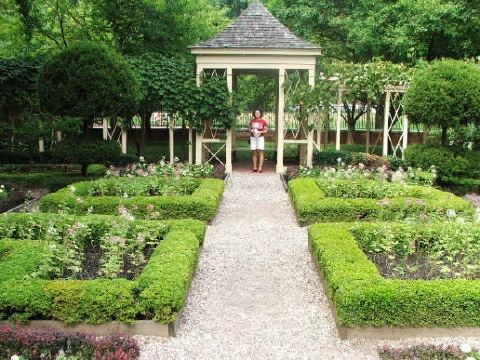
Flowers in a
Philadelphia garden
We were advised to obtain two stick-on forms from a chandlery, which basically confirms that we are aware that it is against the US regulations to discharge oil and various other substances such as untreated sewage overboard. The only rationale for these forms is to confirm our knowledge of the laws, if we are caught dumping items on the list overboard (not that we ever would). Three weeks after refloating a pristine “Light Blue” we have found her waterline once again covered in oil and scum, so someone isn’t abiding by the laws (probably we’re the only ones who are). I wonder if the USCG are as conscientious with the large commercial vessels.
After the boarding, we reached the Wilmington area but we found it too industrial and close to sewage outlets so moved on. We laughed about the coastguard insistence on stick-on warning notices when there is sewage pouring into the rivers. We moved further up river and finally chose a location off the main channel opposite Little Tinicum Island and anchored near a derelict wharf. The view of the riverbank on one side was less than delightful being that of industrial sites, but it lacked sewage and was reasonably sheltered from the mammoth tugs, which ply their trade up and down the river. The view of the little bird sanctuary on the island to the other side was pleasantly refreshing.
I called the Corinthian Yacht Club of Philadelphia and spoke to Jean, the club manager, who informed us that they had mooring buoys in 15 feet depth where we could moor, but because they were refurbishing the club, there was a reduction in their normal services and they had no boat-to-shore launch. For these reasons, they would only charge us $10 per night ($60 per week). I accepted this and the following morning we moved across the river to the other side of Little Tinicum Island. We eventually spent two full weeks on this mooring, while we toured Philadelphia and the Lancaster County of Pennsylvania.
The club is one of the oldest and most prestigious in the United States. It was chartered in 1892 and during the early part of the last century, when the river was dredged effectively, yachts owned by members ranged from 100 feet to 297 feet, several competed for, won and defended the Americas Cup and, during World War II, the club became a naval installation and the large yachts were turned over to the Navy and Coastguard.
One can see from the layout of the club and its grounds that it was once a club frequented by the landed gentry of the state of Pennsylvania and city of Philadelphia. It is easy to imagine grand parties “à la Great Gatsby” being held on a regular basis on the lawns in front of the club with yachts larger than the Royal Yacht “Britannia” anchored in the river, racing organised to far away places and world famous yachtsmen rubbing shoulders with the local rich merchant bankers and politicians.
The refurbishments are progressing well and one can envisage the club taking off again as there is clearly a rich vein of well-heeled and progressive local talent willing to dedicate themselves to its reestablishment as one of America’s leading clubs. We wish them well.
While there, we used the swimming pool, the showers and the restaurant, all of which have a Victorian ambience about them. Wednesday nights is race night and Siobhán was able to participate in the J22 racing, finishing a better than respectable 2nd, 7th and 3rd while I relaxed on the committee boat. After the race we enjoyed the buffet under the marquee when we met many charming members, who were genuinely interested in our travels and kept us engaged in active conversation for a couple of hours, before they all departed to their homes. We were made to feel very welcome, introduced to the Vice-Commodore and met the Commodore and many of the committee, all of whom were so positive about the changes taking place in the club. We could not have chosen a better place to remain for the two weeks in this area. Moreover, we were well looked after by Jean and Joe, Cathy and Pat at the club and allowed every facility within their capabilities, the redecoration notwithstanding.
While we used the Corinthian Yacht Club as a base, we travelled by local 37 bus to the airport (about which more later) and caught the metro on our weekly travel pass into the centre of the city of Philadelphia. We would then walk wherever we had planned.
Rodin Museum
We visited the Rodin Museum with its many stark and unflattering sculptures of Balzac, the “Burghers of Calais” and the “Gates of Hell” overlooked by the “Thinker” and a larger version of that same statue outside the portico. Rodin had been accused of self sculpture in many of his pieces and so, insulted and in a prolonged fit of pique, thereafter, he sculpted his masterpieces with outsized limbs, hands and feet. The lady guide, who showed us around, was truly informative and certainly knew her subject intimately. Well worth the visit.
We then walked up to the Philadelphia museum of Art and spent the whole afternoon there, not missing one of the many eclectic galleries. We both revelled in the fact that the museum not only contained paintings and sculptures, but also furniture (traditional and Shaker), quilts and glassware. There were Japanese and Chinese displays and as well as American paintings many of the most famous of the European painters. We came out of there literally bubbling over with the celebration of world art and delighted with our choice of places to visit.
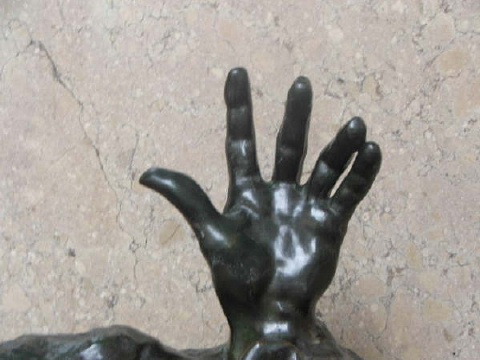
You've got to hand it
to Rodin
The next day we returned to Philadelphia and walked around the streets admiring the original architecture, before we visited the Franklin Institute of Science. After we had both been into the planetarium, Siobhán chose to enter the Tutankhamen exhibition, with its IMAX theatre, tours and various artefacts, while I looked around the rest of the institute. With time to spare, I walked down the road and went into a corner piano bar, which was quiet except for a versatile pianist playing jazz, 70s-90s rock and any requests. I partook of a glass of bourbon with a Bass (of Burton, England) chaser and soaked up the American atmosphere. A very pleasant interlude. I then returned to the Science Institute and met Siobhán, who had had a similarly enlightening experience.
We then walked back to Market Street and caught the train back to the airport and to the yacht club by bus, thoroughly satisfied with our days.
We hired a car for three days to facilitate our access to other areas of Pennsylvania. Within minutes of leaving the marina, we were passing through the western outskirts of Philadelphia and out into the country roads. Soon we were driving more slowly and enjoying the fields of sweet corn and tobacco and various vegetables lining the avenues. Beautifully picturesque white painted farmhouses and Dutch barns indicated our arrival in the Lancaster county area, where the Amish and Mennonite farmers had chosen to settle. I imagined those earlier settlers driving their covered wagons into uncharted areas and selecting the plots of virgin land for their proximity to water, for the good earth, for the views or simply because their relatives or European townsfolk were already established there. Whatever their reasons, the countryside looked prime for farming. Moreover, the farms looked well planned, well maintained and ideally situated.
Quilt Museum
We stopped in the small town of Intercourse, which is thinly spread out along both sides of the highway. We ate in a pleasant restaurant and then browsed several stores, which sold tourist souvenirs, but also locally made quilts and patchwork oeuvres d’art. We were both highly impressed with the Quilt Museum, where I took several photographs of the original and imaginative quilted artwork. While walking around we saw several Amish groups riding in their soberly black but stately horse-drawn buggies. Amazingly, these people have retained their traditional dress, religion and orderly and peaceful way of life surrounded by a nation where xenophobia, corruption, need for speed and change are the norm and whose government is echoing the global warlike tendencies of Genghis Khan, Ivan the Terrible, Alexander the Great and other despots.
We satisfied Siobhán’s quiltophile tendencies, by driving from Intercourse to the north of Lancaster County, where we visited an Amish material shop recommended to Siobhán by the ladies at the Corinthian Yacht Club and where she only bought half the material in the shop. We then headed back to the boat by another scenic route and marvelled at the agricultural prowess in this area in stark contrast to other states, which we had visited.
Harley Davidson
The next day we rose early and headed out west again, but this time we were driving directly to another American legend: The Harley Davidson Production Factory in York, Lancaster County, Pennsylvania. We didn’t know exactly what to expect, but as we arrived we were just in time to catch one of the tours, which leave every 30 minutes. After a short video of the history of Harley Davidson, which was started in 1903 in a shed by four motorcycle enthusiasts, we were given a lengthy, informative and very interesting tour of the factory, including the assembly line, where we saw bikes being built, tested and packed.
We then returned to the foyer where we were allowed to pose on some of the later models and dream. The staff were obviously well looked after by the company as they were so enthusiastic about their product (they are allowed to buy two bikes a year at a reduced rate). We spoke at length to three of the staff about the various models, performance and prices, which with the current rate of exchange was not that expensive (they are advertising the basic Soft tail model on the TV for US$6,000). And we dreamed of course. Unfortunately, Siobhán said we would have to have two as she wouldn’t want to ride on the pillion seat behind me. Well she has completed a CBT course in the UK.
With this marvellous dream tour over, we drove slowly back to the boat by another route, equally beautiful and understood why the Amish call Lancaster County “their heaven on earth.”
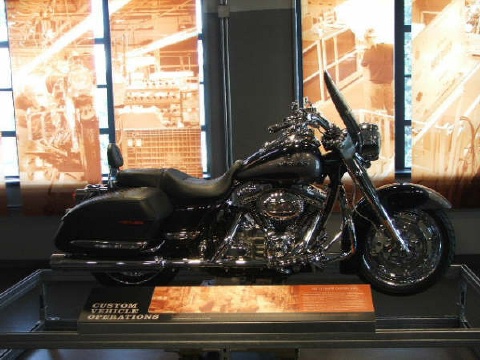
Harley Davidson
custom motorcycle
For the last day of our car hire, we drove into Philadelphia and visited the Italian Market to reprovision with some fresh fruit and vegetables and cheeses from Di Bruno’s Italian deli (with Pink Floyd’s “Dark Side of the Moon” playing in the background). After shopping we enjoyed an epicurean meal in a very busy Italian corner cafe brimming with business people, families and couples. We were struck immediately by the unaffected noisy natural buzz of conversation in American cafes in contrast to quiet English restaurants. It is supported by the efficient activity of the waitresses, the “customer is paramount” quality of service and the freshness and quantity of the food. Doggy bags are a normal sight in restaurants and cafes so that quite often one can carry away another meal to take home, since the portion they serve is too much.
The Italian Market had been recommended to us by several of the yacht club members and we were not disappointed. Like many areas in big cities around the world, they have a continuous changing face and part of the market is now occupied by Korean caterers with their own speciality foods. It was a micro-reflection of the cosmopolitan mix of the American peoples where everyone can call themselves an American, while still maintaining links to their home country, through food, speech, festivals, song and dance. Once again we returned to our boat with another pictorial, atmospheric, olfactory and culinary memory of our American experience. Long may they continue.
Leaving Philadelphia
On 17 August we sailed away from Philadelphia and down the river Delaware and into the Chesapeake and Delaware Canal, another man-made wonder, whose 20 miles saves hundreds of miles of sailing outside in the Atlantic. During this very pleasant canal passage, we saw a large number of turkey vultures wheeling in the air, eating off the river bank and nesting in telegraph poles. One had even built its nest balanced upon an overhead oil pipe. One can differentiate them from other vultures by their red heads and black bodies.
We travelled all day under motor and finally entered the Chesapeake. As we entered I wrote in the log, “We are finally in the Chesapeake and … immediately the difference to what we have seen so far became apparent with houses on the banks, lawns running down to the bay and small pleasure boat pontoons at the bottom of the gardens. We caught the west-going current at the right time and for 5 hours until we anchored we had the tide running with us. As we entered the bay proper we saw several osprey and finally as we entered the Sassafras River another new phenomenon — the Crab Line with hundreds of small buoys spread across the entrance of the river.”
Later I wrote, “Tonight we are keeping an anchor watch because we anchored in only 1.3 metres of water and the wind has piped up to 22 knots from the SW and then NW. So here I am on the middle watch 2-5 a.m. with wind rising and moderating — the sky is full of stars, the wind is not cold and the wind generator is charging like crazy. Siobhán is sleeping peacefully in the aft cabin. Time to write.”
The following day we travelled further up the Sassafras towards Georgetown. We attempted two anchorages, but with our draft we were too far out in the river and I wrote, “so much disturbance from ignorant speed boat and motor boat drivers, who drive too fast without consideration for other water people. We finally anchored 240 yards off the beach in Back Creek” and found this to be very relaxed. We went ashore in the dinghy and took some interesting photographs along the beach, which resembled a Caribbean strand.
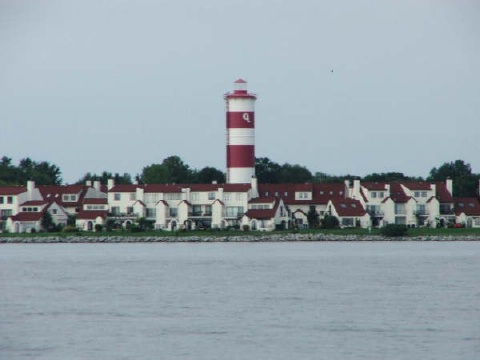
Macum Creek lighthouse
Two days later we sailed right to the end of the river and to Georgetown and picked up a buoy at a reasonable rate and stayed two days there. We found this buoyed anchorage to be very comfortable and the marina that controlled it was extremely well organised with everything for the cruiser.
Buzzards, vultures and osprey were circling the marinas and snatching fish and ducklings from the water and the ducks were sheltering under the boardwalks.
We ventured ashore and cycled along the road to the grocery store on the marina’s complimentary bicycles. We went for a long walk along the road to Skipjack Cove Marina, which was virtually deserted, and saw a small roedeer at the rear of the workshops and luckily got a couple of good camera shots before it frolicked away into the woods.
We met and invited on board an English couple, Steve and Barbara, from “Tenacity”, a Tayana, and we spent a super evening together. They were sailing north while we were sailing south, but we hope to see them along the way to the Caribbean.
On 22 August we sailed down the Sassafras and to the Chester River and anchored off Quaker Neck, a half a mile from the banks, but luckily the wind was in short supply and we slept well. We ventured still further up the tranquil waters of the Chester River, admiring the waterside homes, one of which even had deer on its lawn. There were several duck hides on the banks of the river, not for bird watching but for shooting. The river meanders for about 25 miles through beautiful pastures, marshland and fishing nets, unhurriedly in the summer sun until we could see the bridge at Chestertown, below which we anchored in plenty of space among four other boats. We stayed here for a number of days as the town was exquisitely tranquil, cultured and well laid out. I wrote in the log, “...an idyllic stay in Chestertown during which we had eaten well, found a cyber cafe with ambience, ‘Play it again Sam’, visited the farmers’ market, listened to great Bluegrass music in Andy’s bar”… while eating sumptuous food. We had a very interesting historic tour with the professor who organises the Customs House archaeological museum, where we had ventured on spec. At the end of the tour she was showing us some large pebbles, which they had found in the foundations of the Customs House. Research had revealed that they were from Bideford in North Devon and had been used by one of the merchant ships as ballast. We had actually recognised the stone before she revealed their source. What a small world it is!
While in the anchorage, as so often happens, we met two swell Americans, two of many we have encountered so far, called Brian and Heather on sv “Holding Pattern”. We chatted about their travels and ours while indulging in some light refreshments. They left the day before us but we were certain we would meet up again. (we did in fact in Annapolis early in September). During our stay in Chestertown, we experienced the most severe thunderstorm of our time at sea, with the noise and lightning strikes quite frightening. The wind picked up to 30 knots, which we had not suffered for some time and the boat rocked backwards and forwards, while we kept an anchor watch. It had been quite without warning and a complete surprise to us all. No damage done.
When we were walking to the library in Chestertown, we saw the Department of Social Services building and we went in to enquire about their mission statement and aims. Before we knew it we were in the office of the lady Director and sat and chatted comfortably to her and for a short time her deputy, for about an hour about their issues and solutions. It was amazing just how they compared with those of Somerset and Ealing in the UK.
It was with some regret that we weighed anchor and left Chestertown and headed down the winding river towards the open bay. We anchored for the night at the entrance to the river in Macum Creek and then crossed the Chesapeake bay to the western shore, motoring up the Patapsco River under the Francis Scott Key Bridge and up into Baltimore Inner Harbour, where we were the only yacht anchored.
As one sails under the bridge there is a buoy painted in stars and stripes livery. It is a floating memorial to the spot where Key wrote the words of the USA national anthem. He was imprisoned on a British military prison barge, when he looked up to see if he could see the US flag on nearby Fort Henry and coined those famous words, “Oh say can you see...” etc. etc.…
We sailed on up the river past marinas bursting at the seams, large logs floating in the river and various vessels plying their trade. As we approached the aquarium I started to recognise the inner harbour, which we were surprised to see empty apart from pedalo dragons. The lightship and submarine were still in place where I remember them from 11 years ago, when I had anchored here in “Archrival”, but there had been a great deal of building with the waterfront resembling Portsmouth with its bright array of restaurants and boutiques. We checked with the Baltimore harbourmaster, who confirmed that we could anchor there provided we were out of the channel and between the white marker buoy and the stern of the submarine. We found this easy as there were no other boats and we were soon at peace, drinking a long cool beer and surveying our surroundings.
I found it nostalgic and remembered the loud and repetitive loudspeakers on the submarine as it figuratively dived and surfaced. The modern design of the Planet Earth building, the World Trade Centre and the backdrop of modern office blocks reminded me of that Chesapeake cruise with John and Lyn and friend Linda, which had given me the inspiration to complete my own Atlantic cruise.
We rowed ashore and went for an exploratory walk around the waterfront and found a “La Tasca” restaurant, where I persuaded Siobhán to revisit for tapas and fino, to remind us of our Spanish honeymoon. We enjoyed this romantic tryst and were made to feel very much at home by Valdez the barman, who had been in Andalucia this year and compared notes with us about the various locations there.
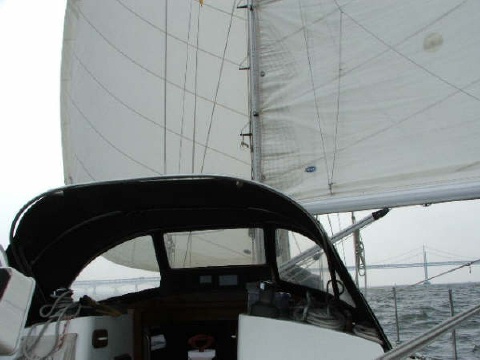
Goosewinged down the
Chesapeake
The following day, we went for a long walk along Eastern Avenue to collect some new lenses from the optician there, sent down from Philadelphia, as they had not been ready when we visited that city. We walked through various communities to reach the shop, including Italian, Ukrainian and Polish. The appointment with the optician took only two minutes and then we caught a local bus, full of different nationalities in this cosmopolitan city, back to the seafront. There was not a glimmer of animosity towards us and we felt no fear, despite having been informed previously that there had been 200 murders in the city this year.
I had visited the optician in Philadelphia because my right eye had become misty. I thought it was my dirty glasses, but after the optician’s examination was informed that I have a cataract in my right eye. It is no problem for me, but I will have to wait till we return to the UK to have it replaced by artificial lens, as it would cost US$ 6,000 per eye here. The new lenses have alleviated the mistiness.
Goosewinged
During the next two days we toured the inner city by foot, and relaxed on the boat and on the evening before we left we were joined in the anchorage and met two extremely pleasant Americans, Mike and Sue on their catamaran “Jus’ Now” and had reciprocal sundowner visits to our respective boats, in fact until it was quite dark. We have noticed in the past week that although the days are still hot, in the 80s, that the evenings are getting darker earlier as the autumn approaches and there is a pleasant cool breeze blowing through the mosquito screens at night.
Because we were meeting our close friends, Simon and Paula in Annapolis on their return from New York and Las Vegas, we left the following morning, 31 August, lifting the anchor at 0830 and sailing down to Patapsco River into the bay and then goosewinged down the bay till we turned right into Annapolis. Later we anchored off the Annapolis Naval Academy with four other boats, but with plenty of room and stayed here until Simon and Paula joined us.
I will finish my narrative here and continue our Chesapeake record in the fourth moon update.
Lots of love and best wishes.
Lawry and Siobhán was there as well.
19 September 2007.
Go to the ... Archives
... or see the photos from this report
